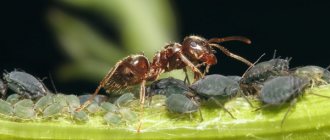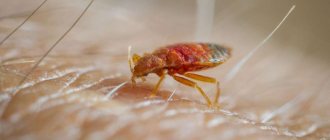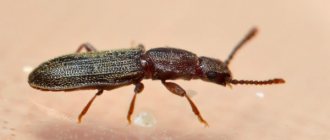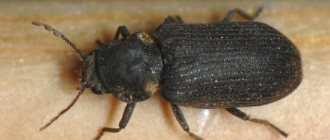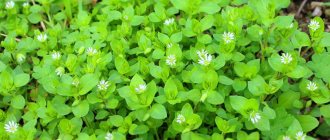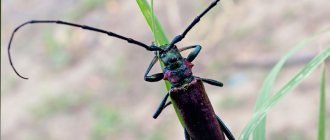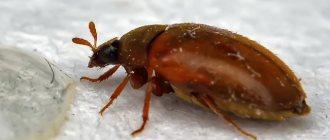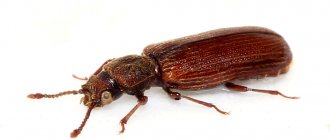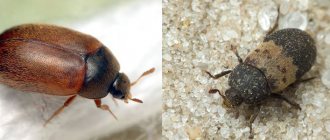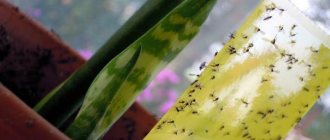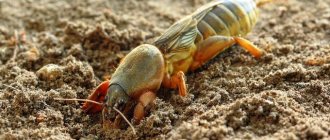The roseate sawfly is an insect that actively parasitizes berry and ornamental crops. It affects rose flowers, most often rose bushes, which is why it got its name. The most harmful are the larvae - these inconspicuous creatures eat succulent foliage with appetite and as a result, after their invasion, only bare twigs remain on the bushes. They can also gnaw through shoots, which is why plants begin to rapidly wither. Is there any salvation from this scourge?
Preventive methods of control
Even if the sawfly and borer have not been seen on roses this year, it is better to carry out preliminary work to prevent the appearance of pests.
| Autumn | Spring |
| Cleaning the rose garden from fallen leaves. | Cleaning up dry plant residues after winter. |
| Pruning roses and fruit trees. | Pruning affected shoots before leaves bloom. |
| Burning pruned branches. | |
| Disposal of dry leaves and branches - removal to specially equipped places, or deep burial. | |
| |
| Loosening the soil around roses. | Preventive treatment of bushes and soil with insecticides immediately after the snow melts. |
| Spraying the crowns of bushes and the soil under them with protective agents. | |
How to treat roses against other pests
Orchid pests: treatment options and control of parasites
A danger to roses is posed by other insects that parasitize not only roses, but also nearby plants, bushes, and trees.
Spider mite
The most common rose pest. Leads to a general weakening of the flower. The leaves are falling. Immunity decreases. The plant becomes vulnerable to many infectious diseases.
Spider mites form large colonies
The peculiarity of the insect is the rapid change of generations and adaptation to toxic substances. It is necessary to treat the bushes every three days. You can use chemicals such as:
- Sunmite;
- Flumite;
- Apollo.
Thrips on roses
A sign of an insect attack is a grayish-brown coating on the foliage of roses. Thrips feed on cell sap. First, colorless spots appear. Then they increase in size. Holes appear from dead parts of foliage. The buds are deformable. They fall off prematurely without blooming. The pest is mobile, which is why it quickly moves from a diseased plant to a healthy one.
After infesting a bush, thrips leave sticky secretions on the plant.
Important! Thrips not only destroy the rose by drinking its juice. They are capable of transmitting viral diseases.
Shchitovka
The female scale insect is able to camouflage itself in the color of the foliage. It's difficult to notice. Just based on general characteristics:
- small red or brown inclusions;
- sooty coating;
- stops active plant growth.
It is recommended to constantly inspect the rose. Especially the back side of the leaves. When a sticky coating appears, you need to start treatment. There is no special means of combating scale insects. It is necessary to treat the foliage with a soap solution. The procedure is repeated after a few days.
Important! Spraying with a soap solution gets rid of not only scale insects, but also a number of other pests.
Leaf Cutter Bee
After being attacked by insects, perfectly smooth oval or round holes are left. The bee does not eat them, but makes a home for itself. The harm to the rose is minimal. Doesn't cause much damage. There is no need to use chemicals. Organic treatment from bees is sufficient.
Weevil
The weevil is a fairly large beetle, reaching a size of 10 mm. It is difficult to identify because the insect is nocturnal. Leads an active lifestyle at dusk. Adults eat leaves. The larvae destroy the root system of the rose, hiding in the thickness of the earth.
Barely noticeable weevils that lead a nocturnal lifestyle. In the morning, only eaten leaves remain
To get rid of weevils, it is recommended to use insecticides. Spraying is done in the evening. "Aktara" or "Inta-vir" are used.
Ants
The main danger ants pose is the spread and protection of aphids. To protect the vegetation in the garden, it is recommended to spray the soil near the rose with water with aromatic spices and essential oils. Pungent odors will repel insects, preventing them from harming the flowers. Prevention is an important condition for a healthy garden.
Methods of control using chemicals, taking into account the characteristics of pest development
When the adult caterpillar reaches the ground, pupation occurs, which lasts 14 days.
The cocoon matures with the onset of warm weather. The approximate timing of the appearance of adults is the end of May. Taking into account weather conditions, a more accurate time is the flowering of garden strawberries. At this time, it is important to prevent the caterpillar from ending up in the soil. It is important not only to choose the right protective agent against sawfly and borer, but to apply it in time. To do this, you need to know the reproduction cycles of insects.
The sawfly larva is called a false caterpillar and appears at the end of April. At the beginning of development it is white in color and 4 mm long. After a month, the formed body acquires black spots, and the underside of the abdomen turns yellow.
Young larvae accumulate in groups and, as they mature, spread throughout the bush. As adults, after about a month, they move to the soil to pupate.
At this time, you can deal with them using an environmentally friendly method - collecting them by hand .
The flight continues until July. If during this period you notice a small flying insect, 1 cm in size, black and yellow in color, this means that there is a sawfly in the rose garden and you need to treat the bushes with protective insecticides.
Damage caused
Depending on the species, pests can climb up shoots, destroying leaves (ascending sawflies), or descend from the tops of stems (descending sawflies).
- Going down, the false caterpillar gnaws the shoot, making a move in it. The stems of the plant begin to darken and wither.
- Rising upward, the larva moves along the underside of the foliage, eating away the fleshiest areas and leaving behind a characteristic skeleton of veins.
Pests attack roses, causing losses to flower growers. They also feed on rose hips, reducing its yield and thereby affecting the production of cosmetic products and medicines.
It is very effective to use attractants to lure and subsequently destroy harmful insects. The apple blossom beetle causes enormous damage to fruit trees such as apple trees, pears, and quince. Read our article on how to deal with this dangerous insect.
The codling moth damages the pulp of the fruit. You will learn what to do to save your harvest at https://stopvreditel.ru/rastenij/selxoz/yablonevaya-plodozhorka.html link.
Traditional methods of preventing and exterminating sawfly
The smell of common tansy repels roseate sawflies and borers.
In cases where the use of chemicals is not possible, it is better to use more gentle methods. Experienced gardeners use the following methods of preventative protection of roses from sawfly and borer:
- Plants are planted whose smell repels pests. The Rosary can be surrounded by the following “protectors”:
– rejected marigolds, French marigolds, large-flowered marigolds,
– pyrethrum maiden, Caucasian, hybrid,
– yarrow officinalis,
– common tansy,
- wormwood,
– calendula officinalis.
- If roses are located near the garden, then it is better that the closest neighbors are:
– nightshades – tomatoes, eggplants, potatoes,
- hot pepper,
- bird cherry.
The smell of these plants repels insects and acts as a repellent on them.
If pests do appear, you can use herbal decoctions and infusions to combat us. The most popular cooking recipes are:
| Decoction of tomato or potato tops | 4 kg of crushed raw materials are poured with ten liters of water, left for half an hour, then boiled for 30 minutes. After cooling, add 50 g of laundry soap. |
| Hot pepper infusion | 1 kg of hot pepper pods is poured into 10 liters of water and left for 10 days. A mother solution is obtained, which is filtered and stored in a sealed container. Before spraying, ½ liter is diluted in ten liters of water. Use safety glasses and a respirator while working. Make sure that the solution does not come into contact with pets. |
| Bird cherry decoction | Fresh or dry branches and leaves are suitable for preparing the solution. You will need crushed raw materials per 10 liters of water. After boiling, cook over low heat under a closed lid for 45 minutes. |
| Tobacco infusion | The product is prepared in a ratio of 1:10 and left for 24 hours. Filter before use. For spraying, the infusion is diluted by half and laundry soap is added - 50 g. |
In addition to plant materials, a solution of soda ash is prepared against the sawfly and borer:
- 3 – 4 tablespoons per 10 liters of water. Multiplicity of treatments 3 – 4 times.
Features of the insect
The insect can reach lengths from 2 to 32 millimeters. Due to the connection of the head with the body, the insect is called a sessile belly. The head of this insect is large and mobile. The jaws are developed. The larvae of this insect, as soon as they are born, begin to eat various plants. Due to this, colossal damage is caused to crops. In larval form, this insect resembles a butterfly caterpillar. After the caterpillars are full, they begin to build cocoons on the ground. In summer, the next generation of insects hatches from the cocoon. Eating of foliage by these insects occurs almost all summer.
Threat of sawfly damage to different types of roses
The Crown Princess Margarita variety is one of the varieties that is not resistant to damage by the roseate sawfly.
Unfortunately, there are no varieties that can be said to be not damaged by pests. This does not depend on the group to which the rose belongs. It often happens that insects live on one of the varieties growing nearby, but not on the other. Gardeners have noticed that the sawfly chooses:
- Flammentanza from the group of climbing roses,
- Ilse Krohn Superior - white flowering climber.
- Crown Princess Margaret is a representative of English roses.
You can reduce the damage to roses of any variety and type if you do not plant them next to an orchard or ornamental plants of the Rosaceae family.
Rose leafhoppers
rose leafhopper on a rose
When rose leafhoppers appear, you will see white spots and specks on the upper side of the leaf. These yellowish or white winged insects lay eggs on the back of the leaf, from which larvae then hatch. They suck the juice and contribute to the appearance of these stains. As a result, the leaves dry out and fall off prematurely. Dry weather contributes to the appearance of the roseate leafhopper. It also happens that with severe damage, the plant slows down its growth and even partially loses its foliage.
Category: “Questions and answers”
Question No. 1. How long do sawflies live?
An adult adult lasts only 10 days, but during this time each female lays an average of up to 70 eggs. If you don't fight them, they will destroy the rose garden.
Question No. 2. How long does it take to get rid of the sawfly?
If there are few pests and the treatment is carried out on time, then once is enough. But, it is better not to risk it and carry out additional spraying and preventive work in the fall and spring of next year. You cannot be sure that the insects will not appear again.
Thrips
These pests most prefer fragrant roses with light-colored flowers, but can also cause damage to other plants. Brown or black spots appear on the buds and flowers, the petals look chewed and darkened.
If you rub the flower or look into its core, you can find fast-moving small black insects about 2 mm long. These are thrips - the most difficult pests of roses. As a rule, they appear in hot and dry weather.
Control and prevention measures:
|
What to do if there are caterpillars on rosehip leaves
If there are caterpillars on a rosehip, the first thing to do is to correctly identify the pest and carry out treatment against it. The following describes how to eliminate caterpillars on rosehip leaves if the plant is affected by a large number of lancets.
Maple shooter.
Maple shooter Acronicta aceris L. - a butterfly with grayish wings with a span of 35-45 mm. The caterpillar is up to 50 mm long, covered with large tufts of long yellow-red hairs located along the back in two rows. In the middle of the back there is a row of large diamond-shaped spots surrounded by a black border. The pupa is dark brown, in a cobweb cocoon. The caterpillars feed from June to September, damaging the leaves of maples and many hardwoods and shrubs. Occasionally found on rose hips.
Control measures. Collection and destruction of single caterpillars. In case of large numbers, spraying is carried out with one of the following drugs: fufanon, kemifos, actellik, kinmiks, spark, Inta-Vir.
Small shooter.
Small shooter Apatele strigosa Schiff. (syn. Acronicta strigosa F.) is a butterfly with violet-gray forewings. In the middle of the wings there is a yellow-gray spot with a black border on the inside. The hind wings are gray. The body is thick, wedge-shaped, the abdomen is narrowed towards the end, the thoracic part is covered with long dense hairs.
The caterpillars are green, with a uniform red-brown dorsal side and small light warts. The flight of butterflies is observed in July-August; after fertilization, females lay eggs on the leaves of trees and shrubs.
The caterpillars hatched from eggs feed and develop from July to October, roughly eating the leaf blades. Having finished feeding, the caterpillars go into the soil and pupate in earthen cradles. In addition to rose hips, the small shooter damages apple trees, plum trees, raspberries, buckthorns, and hawthorns.
Control measures. The same as against maple shooter.
Psi shooter.
Acronicta psi L. (syn. Apatele psi L.) is a butterfly with gray wings that have a span of 36-40 mm. The front wings have a brownish tint and black strokes at the base and on the outer field, the hind wings are gray-brown, darker at the edges. The caterpillar is black, up to 40 mm long, on the fourth segment it has a long, pointed bump, and on the eleventh segment there is a small tubercle, the back is light yellow, on the sides there are white-gray stripes with short red stripes, the leg line is white. The cone is covered with short black hairs, and the entire body is covered with sparse gray hairs. Butterflies fly in July-September, caterpillars feed on the leaves of fruit trees and shrubs, as well as deciduous trees.
Control measures. Collection and destruction of single caterpillars. In case of large numbers, spraying is carried out with one of the drugs: Fufanon, Kemifos, Kinmiks, Actellik, Inta-Vir, taking into account the waiting period.
Red "relative"
The description of this category was first carried out by the French zoologist Geoffroy Saint-Hillaire (1785). The features of this unit are given below:
- The eggs are oval in shape and white with a yellow tint.
- The pupa is placed in a hard cocoon of yellow-golden color. Placed in coniferous crust until departure time.
- The larva is gray with a black head. There is a black stripe with white accents on the back. Its size can reach 25 mm. The general behavior is similar to that of the common sawfly.
- The male reaches a length of about 7 mm, has a black color and feathery mustache.
- The female is larger than the male (up to 9 mm). The color is completely red, the body is round in shape.
It is worth noting that females of the red pine sawfly are capable of producing offspring without the participation of a male. In this case, only male individuals appear.
